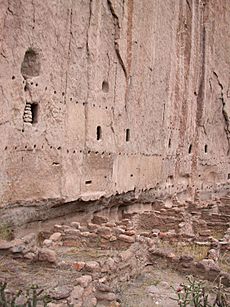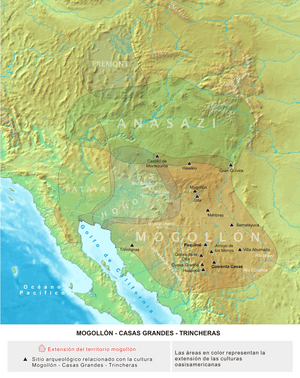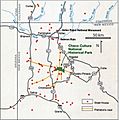Ancestral Puebloan dwellings facts for kids
Hundreds of Ancestral Puebloan dwellings are found across the American Southwest. These amazing towns and villages were mostly built long before the year 1492. You can find them all over the Southwest's unique landscape.
Many of these ancient homes had ways to protect themselves. For example, some were built on high, steep flat-topped hills called mesas, like the famous Mesa Verde complex. Others, like the modern-day Acoma "Sky City" Pueblo, are still lived in today. From before 900 CE and past the 13th century, these large communities were important cultural centers for the Pueblo peoples. There were also many smaller settlements scattered throughout the region.
Contents
Who Were the Pueblo People?

Ancient Pueblo Cultures
The Ancestral Puebloans lived in a large area covering parts of Arizona, New Mexico, Colorado, Utah, and even a bit of Nevada. They lived mostly north of other ancient cultures like the Hohokam and Mogollon, and south of the Fremont culture.
Modern Pueblo Cultures
Today, there are 21 Pueblo groups officially recognized by the United States government. These groups are often called "eastern Pueblos" (like those along the Rio Grande River) or "western Pueblos" (like the Zuni and Hopi tribes).
Some of the modern Pueblo groups include:
- Hopi Tribe of Arizona
- Kewa Pueblo, New Mexico
- Ohkay Owingeh Pueblo, New Mexico
- Pueblo of Acoma, New Mexico
- Pueblo of Cochiti, New Mexico
- Pueblo of Isleta, New Mexico
- Pueblo of Jemez, New Mexico
- Pueblo of Laguna, New Mexico
- Pueblo of Nambe, New Mexico
- Pueblo of Picuris, New Mexico
- Pueblo of Taos, New Mexico
- Zuni Tribe of the Zuni Reservation, New Mexico
Where Did They Live?
The homes of the Pueblo peoples are found all over the American Southwest and even in northern Mexico. You can find evidence of their dwellings in states like New Mexico, Colorado, Utah, Arizona, and even parts of Texas and Nevada. In Mexico, they are found in the states of Chihuahua and Sonora.
Important Time Periods

Archaeologists have divided the history of the ancient Pueblo peoples into three main time periods:
- Pueblo I (around AD 750 to 900): During this time, Pueblo buildings started to be made with stone. They often had windows facing south and were shaped like U's, E's, or L's. Buildings were built closer together, showing more community life. Towers were built near special underground rooms called kivas, likely used for watching out. Pottery became more varied, used for cooking, drinking, and serving food. White pottery with black designs, made from plant pigments, also appeared. People also started using smart ways to manage water, like building reservoirs and dams.
- Pueblo II (around AD 900-1150): The population grew a lot during this period, leading to over 10,000 new sites being built in just 150 years! Since the land was often dry, people hunted, gathered wild foods, and traded pottery for food. By the end of this period, many homes were two stories tall and made of stone. Towers and both family and community kivas were common.
- Pueblo III (around AD 1150-1300): This was a time of big change. People moved from scattered farms into larger community centers, often in canyons or in cliff dwellings. The population in the Mesa Verde area reached over 20,000 people between 1200 and 1250. However, by 1300, the Ancient Pueblo People left their settlements. This was likely due to changes in climate and a shortage of food, causing them to move south to villages in Arizona and New Mexico.
How They Built Their Homes
The ancient Puebloans were famous for their amazing apartment-like buildings and structures. Places like Chaco Canyon, Mesa Verde, and Bandelier show off their skills. They built with stone, adobe mud (a mix of clay, sand, and straw), and other materials found nearby. Some homes were even carved right into the sides of canyon walls!
The buildings inside these natural rock shelters were mostly made of hard sandstone, held together with adobe mortar (like cement). While each building was unique because of the different shapes of the canyon walls, they shared many similar features.
A common design element in these sandstone and adobe buildings, whether on cliffs or flat ground, was T-shaped windows and doors.
Building Features

Most Pueblo structures were made of adobe and looked like apartment buildings. They often had a wide base, with smaller sections built on top, sometimes reaching four or five stories high! These buildings had different floors for storage, defense, living, and religious ceremonies. For safety, the ground floor usually didn't have doors until more recent times. This meant people used movable ladders to get inside. One ladder would lead to a patio or the second floor, and another would go through an opening in the roof to the first floor. More ladders led to higher floors.
Architectural Details

A very important skill of the Pueblo peoples was their irrigation techniques. They used these methods to bring water to their homes and farms, and this often decided where communities were built.
Many Pueblo buildings have T-shaped doors in their adobe walls. These doors are usually about one meter wide, wider at the top and narrower at the bottom. The large "great house" pueblos were built using a "box system." Builders used molds to pour compacted mud without organic material. The outside was covered with stucco made of sand, lime, and crushed oyster shells, then painted blue, green, or pink. These walls were built without deep foundations, using slots about 25 centimeters deep. Stairs, ramps, and ladders were built to help people get into the buildings.
There were also consistent features around the dwellings, like water storage structures such as the Mesa Verde Reservoirs and stone towers. For a time, pueblos across the Southwest were connected by a network of roads that spread out from Chaco Canyon. Chaco Canyon is thought to have been a very important cultural center. You can still see parts of this ancient road system in New Mexico and Arizona today.
Different Kinds of Homes
Besides the movable shelters used by other Native American groups, the Pueblo peoples created special buildings for living, worship, defense, storage, and daily life.
- Pueblo - This word refers to both a style of Puebloan architecture and the groups of people themselves. In terms of building, a pueblo is a multi-story, apartment-like building made of adobe. In this article, the largest ones are called "great houses."
- Great houses - These large Pueblo dwellings were usually built on flat plains, not cliffs.
- Pit houses - Many people in the ancient Southwest lived in pit houses. These were carefully dug rectangular or circular holes in the ground with walls made of wattle and daub (woven branches covered with mud) or adobe, supported by strong log posts.
- Cliff dwellings - These homes were built into the sides of mesas and mountains in the Southwest. Many of the Pueblo people's defensive structures were cliff dwellings.
- Jacal - This is a traditional adobe house. It was built using slim, close-set poles tied together and filled with mud, clay, and grasses, or sometimes adobe bricks were used for the walls.
Where to Find Dwellings
You can find Ancestral Puebloan dwellings in many states and even in Mexico! Here are some of the places:
Arizona
Chihuahua (Mexico)
Colorado
New Mexico
Utah
Nevada
One important site in Nevada is Pueblo Grande de Nevada, which are ruins of a great house near Overton.
Texas
In Texas, you can find sites like Firecracker Pueblo and Hot Well Pueblo near El Paso. The Ysleta Del Sur Pueblo in El Paso is still an active Pueblo community today.
Sonora (Mexico)
In Sonora, Mexico, an important site is Cerro de Trincheras|es, which contains ruins.
Images for kids





